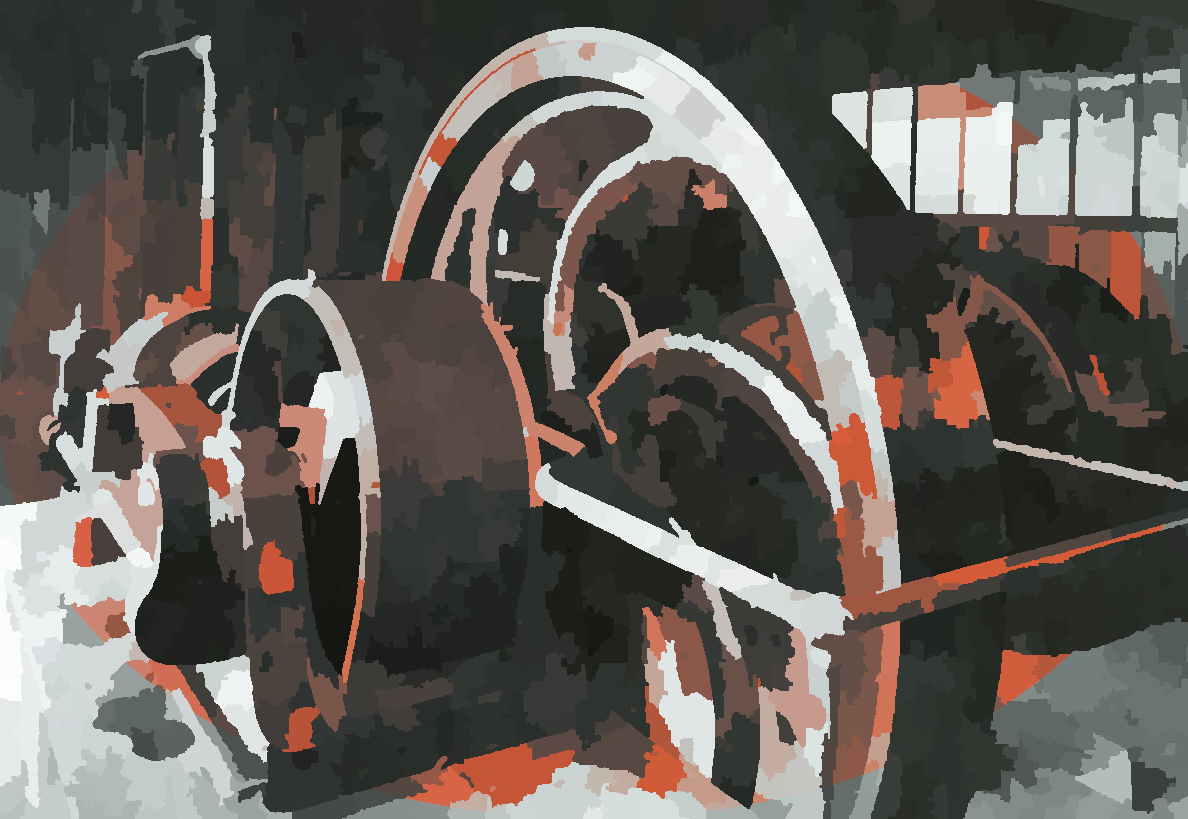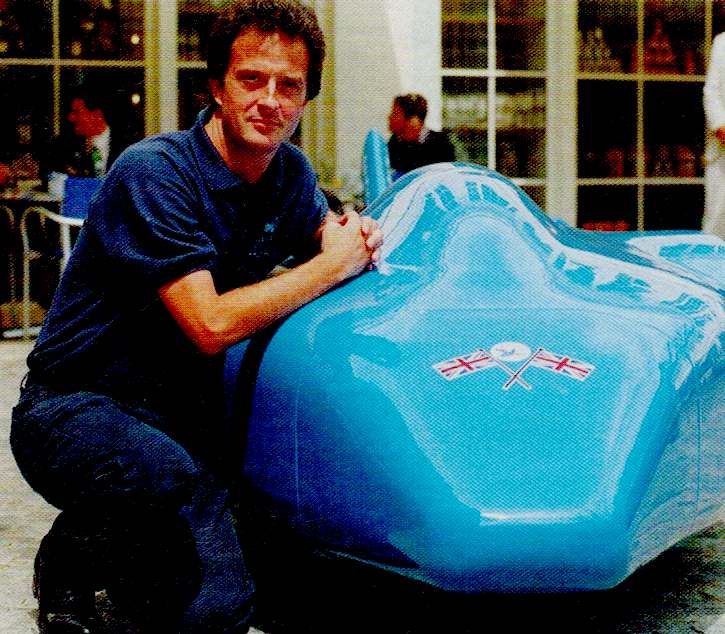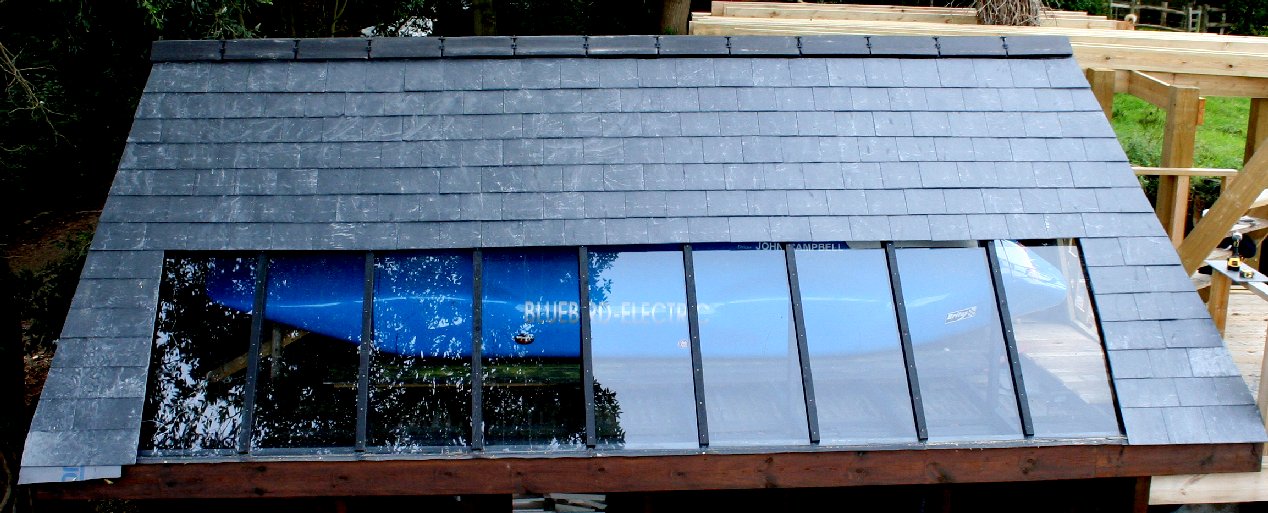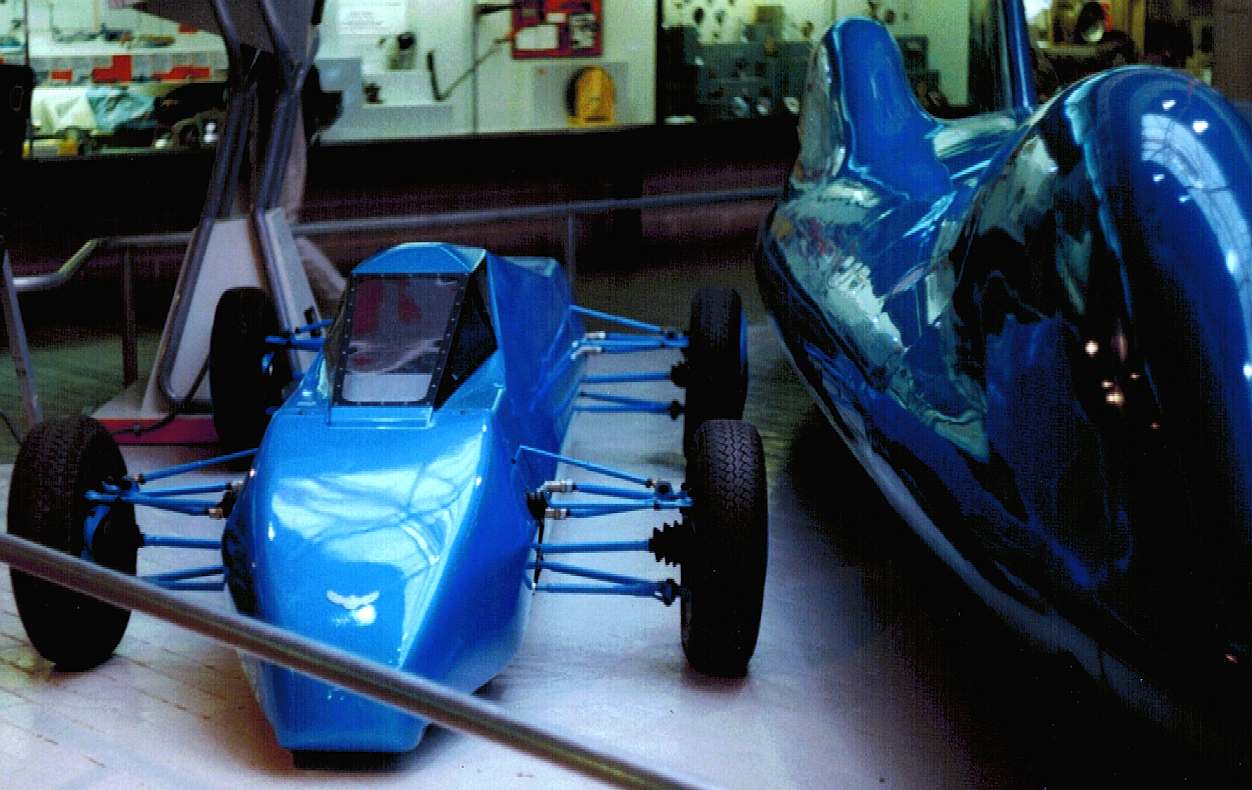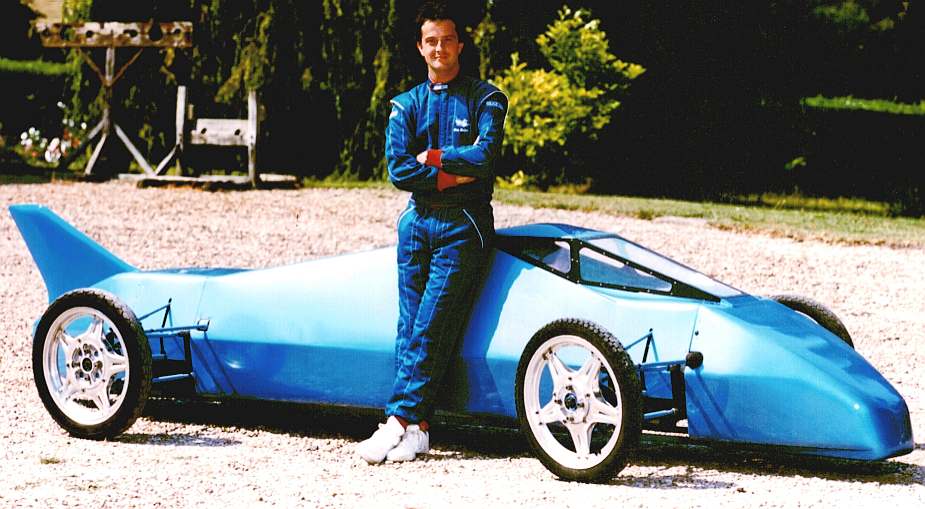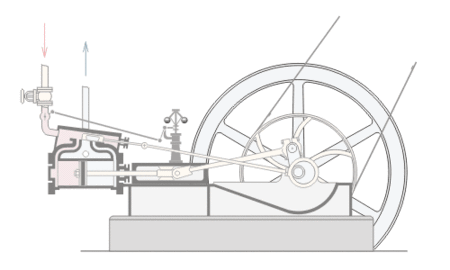|
BLUEBIRD 2 ELECTRIC |
BE2-LSR |
|||
|
EXHIBITS FRIENDS HERITAGE HOME LIME PARK OPEN DAYS PARKING TECHNOLOGY |
||||
BE2 - Arguably, the most beautiful of electric land speed record cars, the original Bluebird-Electric 2, was hand built at Herstmonceux, in Sussex. Don Wales is pictured alongside the streamliner, at the Bluebird Store in London.
The BE2 vehicle was not directly connected with the generating history of Herstmonceux Museum, but was built in the workshops in at the Generating Station.
As with the original BE1, the BE2 had the ability to exchange energy cartridges during each of the three allowed runs.
The car was incredibly light. Comprising a thin-wall steel tube spaceframe, with a carbon-fibre body, in final form. The drag coefficient and frontal area were ultra-low, tested in a wind tunnel, against other designs. Further reducing the energy needed for each record run. The seating position was similar to the Bluebird CN7, in the front of the car, ahead of the propulsion machinery. Whereas, in the BE1, the driver sat over the battery tunnel facing forward, like a motorcycle racer.
The Bluebird-Electric 2 was a 600-1200 horsepower machine. More than capable of smashing the then world record, with a top speed estimated to be close on 400mph with the full complement of motors, with CVT potential. That was in 1998, a window of opportunity that never materialized.
BE2 - The purpose built display case, part of the roof of an adjacent building, fitted with glass and lighting. The historic vehicle is an important part of Land Speed Record development. A fine example of British ingenuity.
CARTRIDGE SWAPPING AS REFUELLING
The main competition advantage of this vehicle, as with the BE1, was the energy cartridge exchange system, approved by the Federation International de la Automobile (FIA), as refuelling, and allowed in LSR rules.
WHY BOTHER WITH ADDITIONAL COMPLICATIONS?
Because, in 1995, when this vehicle (and allied recharging patent) were developed, batteries were quite heavy, and held less of a charge. Either rolled plate lead-acid, or nickel-cadmium offered about a quarter that of lithium technology. But, lithium batteries did not exist at the time. Meaning, that most of the weight of a fast electric vehicle from 1991 - 1997, was the batteries.
A car such as this, that could swap batteries in a minute or two, would be very much lighter, hence faster, than a car that needed to carry the batteries for all three runs. The BE2 needing to carry only half the battery weight for each run. An undeniable advantage. A third of the weight of a traditional bolt in battery, if completing three runs.
Whereas, the loading apparatus was comparatively light, using air as the lifting medium.
Though, conventional rapid charging at either end of a course, could have reduced the battery mass, of a bolt in arrangement by some 10-20%. That does not compare to a 66% reduction in battery mass.
As part of the trick exchange system, a cartridge could be unloaded in 20 seconds, by simply depressurizing a specially designed pneumatic cylinder. The thin-wall cylinder was designed as a structural component of the chassis.
With the pneumatic cylinders depressurized, the LSR would roll off the spent cartridge, over the top of a fresh cartridge. The vehicle and chassis being designed especially for this function. Then the onboard pneumatic ram would be charged, lifting and locking the energy cartridge into position, and in around 30 more seconds, the land speed record car was good for the next run. Total recharge time was thus a couple of minutes. With perhaps another minute or two to turn the vehicle around and point in the right direction.
Compare the simplicity of this system, to the complexity of other energy cartridge exchange systems.
BE1 - The Bluebird-Electric 1, was first shown at Beaulieu, the National Motor Museum, with the kind permission of Lord Montagu. The car is seen here incomplete, on transit wheels, without her stabilising fin. The workshop was stillbusy on the car, it was all a bit of a rush, with the paint still drying from the evening before.
In 1952,
Lord Edward Montagu opened Palace House and Gardens to the public for the first time – making Beaulieu among the first ‘stately homes’ to admit visitors. For the grand opening, he displayed five Veteran cars in the entrance hall of the house as a tribute to his late father, John Douglas-Scott-Montagu, who was a motoring advocate and pioneer at the turn of the last century.
HYDROGEN FUEL CELLS
Interestingly, the battery energy cartridge could be swapped for a hydrogen fuel cell power pack. Partly the inspiration for the gullwing city-sports car, built by students very many years later, but using the same workshops in Herstmonceux.
THE RULES
Official land speed record rules allowed the best of 3 runs in different directions, so long as they are within 60 minutes. With this very fast loading mechanism, the BE2 could make three runs without any problems. The FIA rules allowed a competitor to take the best two runs of three, and divide them by two, to give an average over a flying mile, or kilometer, in two directions. These rules were to eliminate downhill runs, and runs with the wind behind a vehicle. Running in the opposite direction gave a fair average.
THE CAMPBELL CONNECTION
The car was to have been driven by Sir Malcolm Campbell's grandson, Don Wales, at the Bonneville Salt Flats, in Utah, USA. It was displayed at the Bluebird Store in London, before being retired in favour of an even faster design. Donald Campbell CBE, of Bluebird K7 fame, was Mr Wales's Uncle. Donald perished tragically at Lake Coniston, when his boat flipped spectacularly, at around 300mph. The Railton, Rolls-Royce Merlin V12 Bluebird, and CN7 (Campbell-Norris) jet powered Bluebird, were the inspiration for these electric vehicles.
Eventually, a lower and longer fully enclosed design was on the cards, to reduce the drag even further. This time with seating at the rear, drag car style. This development was never constructed as a full-size demonstration vehicle. But is on display as a 1:10 scale (33") model, equating to 25.5 feet (8.5m), the design later extended and lowered again, to over 30 feet.
Land speed record breaking is no longer a viable sport for independents. As the speeds have crept up, so have the financial risks. With reduced funding opportunities sounding the development death knell. Only automotive manufacturers have the relatively liberal PR budgets needed. But then, EV sport in 2023, is more about economy and range. See the Jules Verne, JVH2, series of events, by way of example.
BE1 - This well balanced machine, is the original Bluebird-Electric 1, hand built at Herstmonceux and Filching Manor, near Wannock and Polegate, in Sussex. Don Wales is pictured standing beside the sleek machine, with kind permission of Paul and Greta Foulkes-Halbard.
There are several innovative vehicles and vessels on permanent display at Herstmonceux Museum, including:
1. Art Gallery - Collection of paintings, pictures, graphics, sculptures, wooden carvings & exotic glassware 2. Archives - Historic documents library, patents, trademarks, copyright, films, catalogued legal papers & letters 3. An Edwardian ice well, throwback to the days before refrigeration 4. A large underground (condensation/cooling) and water storage chamber for ice making 5. The world's smallest water basin, test tank for model boats & ships to 1:20 scale 6. World's smallest wind tunnel, vehicle drag measuring instrument using electronic strain-gauges 7. Three PV boat models, Navigator, SWATH & 2 cats + route map prior to Swiss PlanetSolar 8. Seavax, the ocean cleanup proof of concept prototype from 2016 - Hall of Plastic, ocean waste, marine litter Vs fish 2050 9. AmphiMax, radio controlled (working) beach launching & recovery vehicle for SeaVax 10. Anthony the most dangerous giant Australian bulldog ant, 300 times normal size - Making Ant's Cart 11. EV - FCEV refueling station model in 1:20 scale 12. The only working (fully functional) water well in Herstmonceux village 13. The fountain of youth, Cleopatra inspired statue supplied from natural well water drawn on site 14. Second World War, 'Anderson Inspired,' bomb proof shelter constructed by Major Charles de Roemer 15. City sports FCEV-BEV, hydrogen gull wing proof of concept DC50 electric car 16. Land speed record car: Bluebird-Electric BE1 (original 1st) with battery cartridge exchange 17. Land speed record car: Bluebird-Electric BE2 (original 2nd) with cartridge exchange 18. A complete mummified squirrel, found when re-roofing the Museum June 2017 19. A fully operational, and restored VW Kombi van dating from 1978 (historic vehicle) 20. BMW i3, battery electric vehicle hybrid, with onboard generator range extender 21. Solar panel, and battery energy storage systems facing north-south and east-west 22. A hornet's nest found on site & preserved in 2016 (reported as [Asian] invasive species, to be safe) 23. Three sewing machines, including an antique Singer and a Brother industrial. 24. Adventure climbing frames for children (back to nature) Swiss Family Robinson 25. 'Elizabeth Swann' proof of concept model 1:20 scale hydrogen powered trimaran 26. Holm oaks, planting and growing trees from acorns on site, re-wilding in Sussex 27. Robotics, mechatronics, electronics and animatronics display - the steel frame, head/jaws, & drives of Anthony (coming soon) 28. Dalek - Full size, drivable working model of the famous Doctor Who BBC TV series, and Peter Cushing film 29. Films - Library of VHS tapes, DVDs and BluRay classics, national treasures, greatest hit, noir, oldies - from 1920 30. PartArt4OW - Proposal for an adapted & illustrated version of the Kulo-Luna script, with local exhibit & art competition 2025
|
||||
|
|
||||
|
EXHIBITS FRIENDS HERITAGE HOME LIME PARK OPEN DAYS PARKING TECHNOLOGY UNESCO
Copyright © 2023 - 2025 Lime Park Heritage Trust. A not for profit organisation with charitable objects.
|
||||
